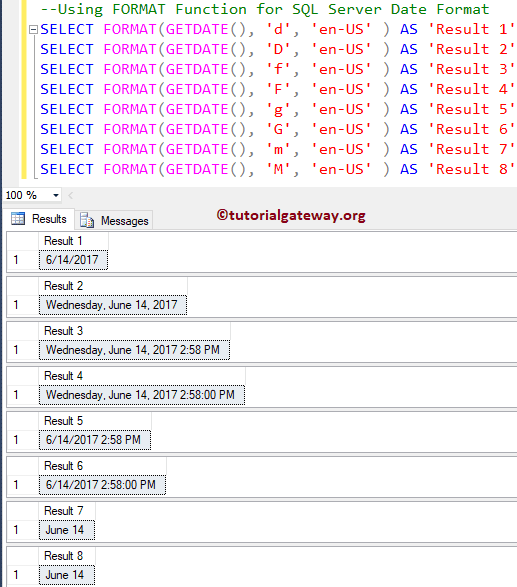

- #Convert datetime to string sql how to#
- #Convert datetime to string sql code#
- #Convert datetime to string sql iso#
- #Convert datetime to string sql windows#
That said, there are good reasons (as Aaron points out in his answer) to use a half-open range instead of BETWEEN (I use style 120 below just for variety): SELECT COUNT(*) Being explicit about the data type and string style results in the following: SELECT COUNT(*) declare myTime as DateTime set myTime GETDATE () select myTime select DATENAME (day, myTime) + SUBSTRING (UPPER (DATENAME (month, myTime)), 0,4) Try not to use any Character / String based operations if possible when working with dates. The question uses strings in ODBC canonical (with milliseconds) format (style 121). Use DATENAME and wrap the logic in a Function, not a Stored Proc. When working with strings and date/time types, CONVERT is to be preferred because it provides a style parameter to explicitly define the string format. SQL Server provides the CAST and CONVERT functions for this purpose. In my view, the neatest way to avoid these types of issues is to be explicit about types. In order to convert a DateTime to a string, we can use CONVERT () and CAST () function.

Without explicit information about the format of the strings, SQL Server follows its convoluted rules for interpreting strings as datetimes. To compare those literals with the datetime column, SQL Server attempts to convert the strings to datetime types, according to the rules of data type precedence. The literals you are providing for comparison to the Created column are strings. | 13:42:00.0000000 | 10:53:21.I do not understand why the data is being converted from varchar to datetime when 'Created' is set to datetime
#Convert datetime to string sql iso#
It does not support basic ISO 8601 format for datetime(yyyyMMddThhmmss). My recommendation is to always store the date/time as a DATETIME or other temporal datatype and only format the date at display time.įor ISO 8601 format for Datetime & Datetime2, below is the recommendation from SQL Server.
#Convert datetime to string sql windows#
If you store a formatted date (which is text), it requires the same gyrations to display the local date format defined either by windows or the app. The reasons for this are many but the most obvious are that, even with a nice ISO format (which is sortable), all future date calculations and searches (search for all rows in a given month, for example) will require at least an implicit conversion (which takes extra time) and if the stored formatted date isn't the format that you currently need, you'll need to first convert it to a date and then to the format you want. do NOT store formatted dates/times in SQL Server. If you absolutely must display ISO date/time formats from SQL Server, only do it at display time.
#Convert datetime to string sql code#
Let the front end code resolve the method of display and only store formatted dates when you're building a staging table to build a file from. You won't find a single SQL that works for both systems. Similar is available in SQL Server documentation.

You may take adavantage from Postfres Data Type Formatting Functions with tochar (currenttimestamp, 'HH12:MI:SS'). Always store your dates and times and one of the SQL Server "date/time" datatypes (DATETIME, DATE, TIME, DATETIME2, whatever). Both have a bunch of datetime + string functions. If you need to convert a date column to ISO-8601 format on SELECT, you can use conversion code 126 or 127 (with. DATEADD(dd, DATEDIFF( dd, 0, DAY ), 0) It avoids the CPU busting 'convert the date into a string without the time and then converting it back again' logic.
#Convert datetime to string sql how to#
5 Hijri is a calendar system with several variations. How to get the DATE portion of a DATETIME field in MS SQL Server: One of the quickest and neatest ways to do this is using. For conversion from datetime or smalldatetime to character data, see the previous table for the output format. Gosh, NO!!! You're asking for a world of hurt if you store formatted dates in SQL Server. In order to INSERT data into a SQL Server table, you don't need any conversion codes or anything at all - just specify your dates as literal strings. 3 Input when you convert to datetime output when you convert to character data.


 0 kommentar(er)
0 kommentar(er)
